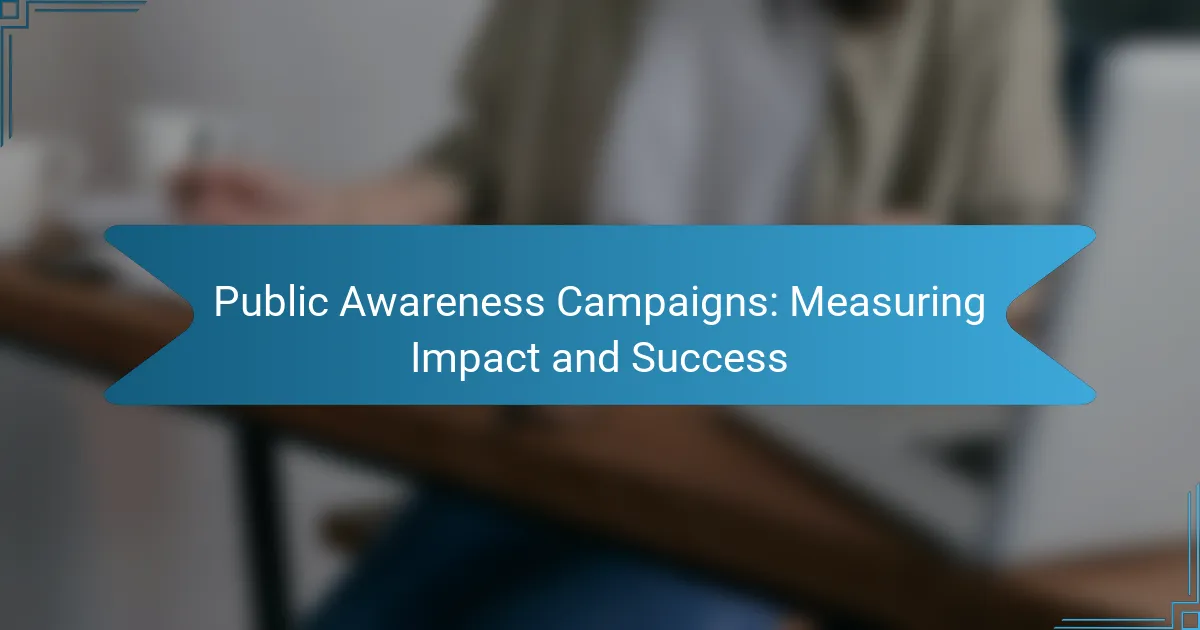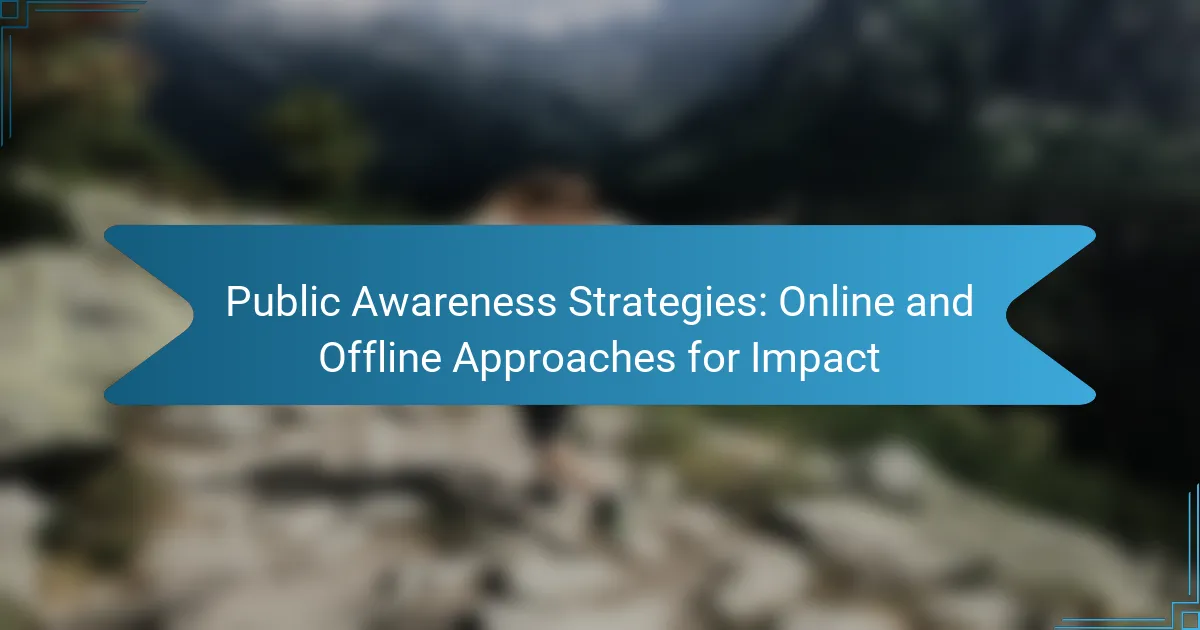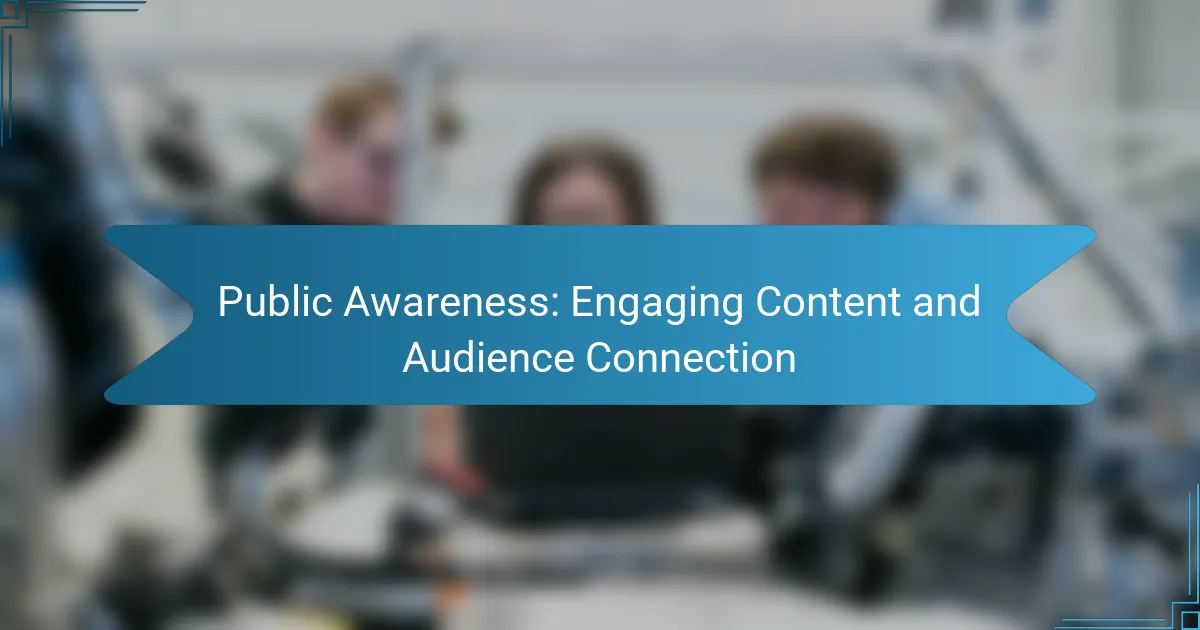Public awareness campaigns play a crucial role in informing and influencing communities on important issues. To gauge their effectiveness, it is essential to measure various metrics such as audience engagement, social media interaction, and media coverage. By employing strategic approaches and utilizing analytical tools, organizations can assess their impact and refine their efforts for greater success.
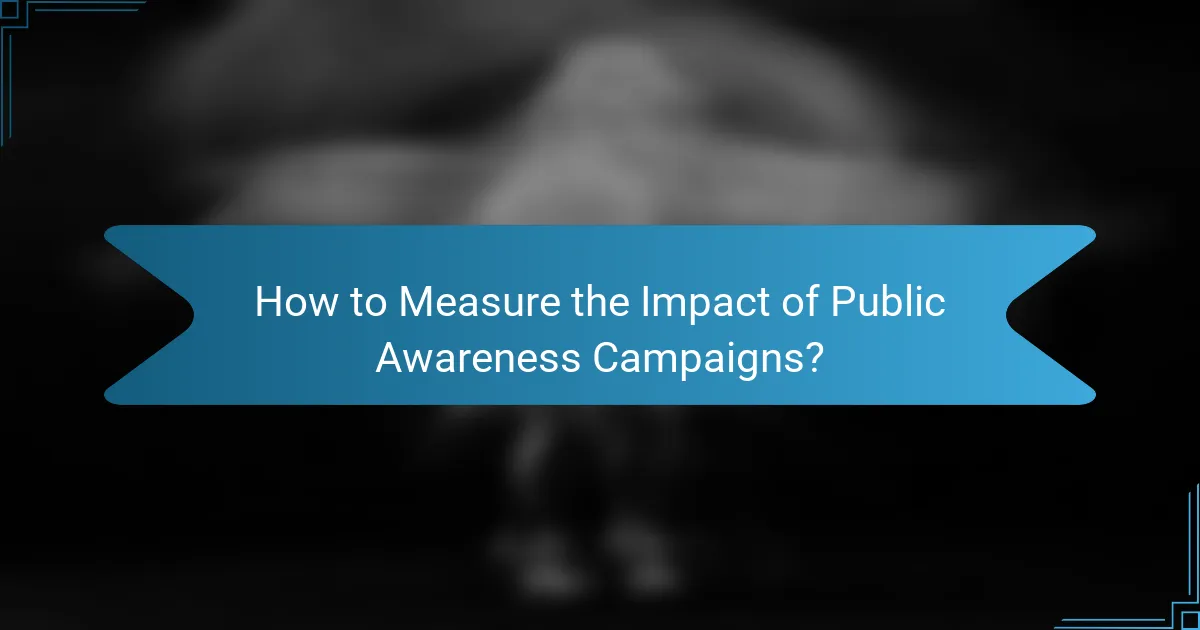
How to Measure the Impact of Public Awareness Campaigns?
Measuring the impact of public awareness campaigns involves evaluating various metrics that reflect the campaign’s effectiveness in reaching and influencing the target audience. Key methods include tracking performance indicators, gathering feedback, analyzing engagement on social media, assessing website traffic, and evaluating media coverage.
Key performance indicators (KPIs)
Key performance indicators (KPIs) are quantifiable metrics that help assess the success of a public awareness campaign. Common KPIs include reach, impressions, conversion rates, and audience retention. Establishing clear KPIs at the outset allows for focused evaluation and comparison against campaign goals.
For instance, if a campaign aims to increase awareness of a health issue, a relevant KPI might be the percentage increase in the number of people who can correctly identify the issue after the campaign compared to before.
Surveys and feedback mechanisms
Surveys and feedback mechanisms are essential tools for gathering direct responses from the target audience. These can include pre- and post-campaign surveys, focus groups, and online feedback forms. They provide qualitative insights into how the audience perceives the campaign and whether it has influenced their attitudes or behaviors.
To maximize effectiveness, keep surveys concise and focused on specific aspects of the campaign, such as clarity of messaging or emotional impact. Aim for a response rate of at least 20-30% for meaningful data.
Social media engagement metrics
Social media engagement metrics offer valuable insights into how audiences interact with campaign content. Key metrics include likes, shares, comments, and overall reach. Monitoring these metrics helps determine which messages resonate most with the audience and can guide future content strategies.
For example, a campaign that generates high shares on Facebook may indicate strong community interest, while low engagement might suggest a need for message adjustment. Aim for a consistent increase in engagement rates throughout the campaign duration.
Website traffic analysis
Website traffic analysis provides data on how many visitors engage with campaign-related content online. Tools like Google Analytics can track metrics such as page views, unique visitors, and average session duration. Analyzing this data helps assess the effectiveness of online outreach efforts.
Look for spikes in traffic that correlate with specific campaign activities, such as social media posts or email blasts. A 20-40% increase in traffic during a campaign period is often considered a positive indicator of success.
Media coverage evaluation
Evaluating media coverage involves assessing how often and in what context the campaign is mentioned in news articles, blogs, and other media outlets. This can be measured through media monitoring services that track mentions and sentiment analysis. Positive media coverage can significantly enhance campaign visibility and credibility.
Consider creating a media coverage report that includes metrics such as the number of articles published, audience reach of those articles, and the tone of the coverage. Aiming for a mix of local and national coverage can maximize impact.

What Are Effective Strategies for Public Awareness Campaigns in the UK?
Effective strategies for public awareness campaigns in the UK focus on engaging the target audience through relatable content and accessible platforms. Key approaches include leveraging social media, collaborating with local influencers, hosting community events, and forming partnerships with NGOs.
Utilizing social media platforms
Social media platforms like Facebook, Twitter, and Instagram are essential for reaching a broad audience quickly. Campaigns should create shareable content that resonates with users, encouraging them to spread the message further. Regular updates and interactive posts can enhance engagement and visibility.
Consider using targeted ads to reach specific demographics, which can be particularly effective in urban areas. Monitoring engagement metrics helps refine strategies and improve future campaigns.
Collaborating with local influencers
Partnering with local influencers can significantly amplify a campaign’s reach and credibility. Influencers who align with the campaign’s values can authentically convey messages to their followers, making the content more relatable. This strategy is particularly effective in niche markets or specific communities.
When selecting influencers, focus on those with a genuine connection to the cause and a strong local presence. Establish clear expectations and provide them with the necessary resources to communicate the campaign effectively.
Implementing community events
Community events serve as a powerful way to engage the public directly. Organizing workshops, seminars, or fun activities can draw attention and foster a sense of involvement. These events should be tailored to the community’s interests and needs to maximize participation.
Utilize local venues and collaborate with community leaders to enhance credibility and attendance. Providing incentives, such as giveaways or refreshments, can also encourage participation and create a positive atmosphere.
Leveraging partnerships with NGOs
Forming partnerships with non-governmental organizations (NGOs) can enhance the effectiveness of public awareness campaigns. NGOs often have established networks and expertise in specific issues, providing valuable insights and resources. Collaborating with them can also lend credibility to the campaign.
Identify NGOs that align with the campaign’s goals and explore opportunities for joint initiatives. This could include co-hosting events, sharing resources, or cross-promoting content to reach a wider audience.
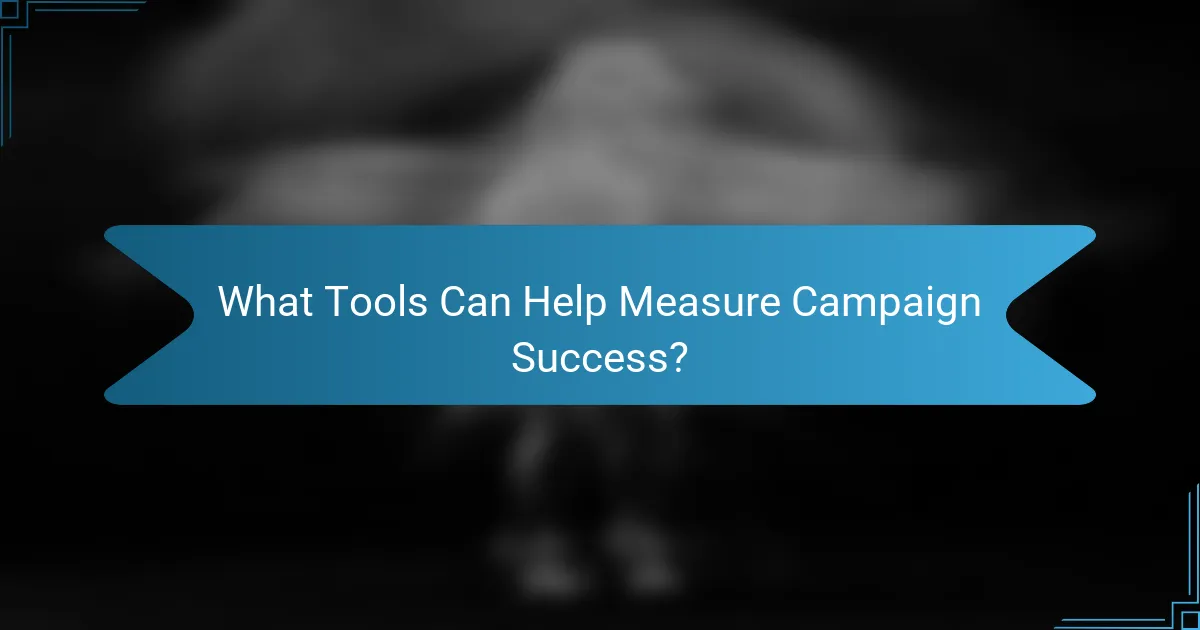
What Tools Can Help Measure Campaign Success?
To effectively measure the success of public awareness campaigns, various tools can provide valuable insights into audience engagement and overall impact. Utilizing a combination of analytics platforms, social media trackers, and feedback surveys can help organizations assess their campaign performance and make informed adjustments.
Google Analytics
Google Analytics is a powerful tool for tracking website traffic and user behavior, making it essential for measuring campaign success. By setting up goals and conversion tracking, organizations can see how many visitors engage with campaign-specific content and complete desired actions, such as signing up for newsletters or making donations.
To maximize its effectiveness, ensure proper tagging of campaign URLs to distinguish traffic sources. Regularly review the data to identify trends and adjust strategies accordingly, focusing on metrics like bounce rates and session durations to gauge user engagement.
Hootsuite for social media tracking
Hootsuite is a comprehensive social media management tool that allows organizations to monitor engagement across multiple platforms. By using Hootsuite’s analytics features, campaigns can track metrics such as likes, shares, and comments, providing insights into audience sentiment and reach.
Set up custom reports to evaluate the performance of specific posts or campaigns over time. This can help identify which content resonates best with your audience, allowing for more targeted future efforts. Be mindful of the varying engagement patterns across different social media channels.
SurveyMonkey for audience feedback
SurveyMonkey is an effective platform for gathering direct feedback from your audience regarding campaign impact. By creating tailored surveys, organizations can assess public perception, awareness levels, and overall satisfaction with the campaign’s messaging and objectives.
To enhance response rates, keep surveys concise and focused, ideally taking no more than a few minutes to complete. Consider incentivizing participation with small rewards, and analyze the results to identify areas for improvement and gauge the effectiveness of your outreach efforts.
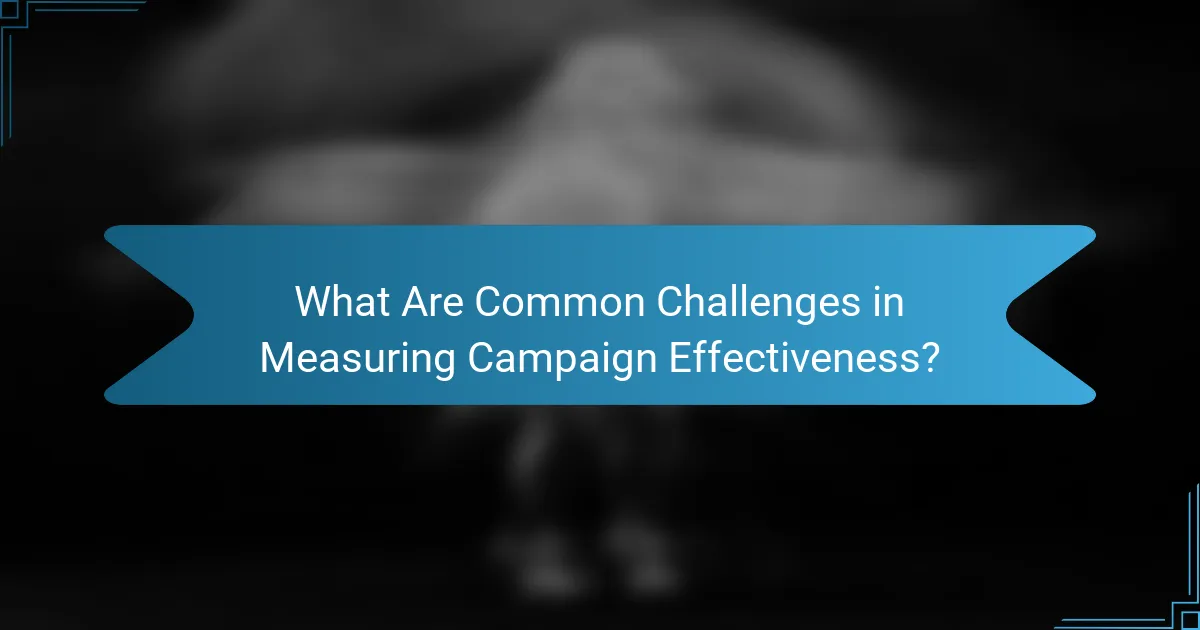
What Are Common Challenges in Measuring Campaign Effectiveness?
Measuring the effectiveness of public awareness campaigns presents several challenges that can hinder accurate assessment. Key issues include difficulties in data collection, attribution problems, and budget constraints that limit the scope of evaluation.
Data collection difficulties
Collecting reliable data is often a significant hurdle in measuring campaign effectiveness. Many campaigns rely on surveys or social media metrics, which can be biased or incomplete. Ensuring a representative sample and high response rates is crucial but can be logistically challenging.
Additionally, data privacy regulations, such as GDPR in Europe, can restrict access to certain types of data, complicating the collection process. Campaign organizers should consider using multiple data sources to triangulate findings and enhance reliability.
Attribution issues
Attributing changes in public awareness or behavior directly to a specific campaign can be difficult. Many factors influence public perception, making it hard to isolate the impact of a single initiative. For instance, external events or concurrent campaigns can skew results.
Using control groups or pre- and post-campaign surveys can help clarify attribution. However, these methods require careful planning and may not always be feasible within tight timelines or budgets.
Budget constraints
Limited budgets can restrict the tools and methods available for measuring campaign effectiveness. Organizations may not have the resources to conduct comprehensive evaluations or invest in advanced analytics tools. This can lead to reliance on less effective, simpler measures.
To maximize impact within budget constraints, prioritize key performance indicators (KPIs) that align closely with campaign goals. Focus on a few high-quality metrics rather than attempting to measure everything, ensuring that resources are allocated effectively.
